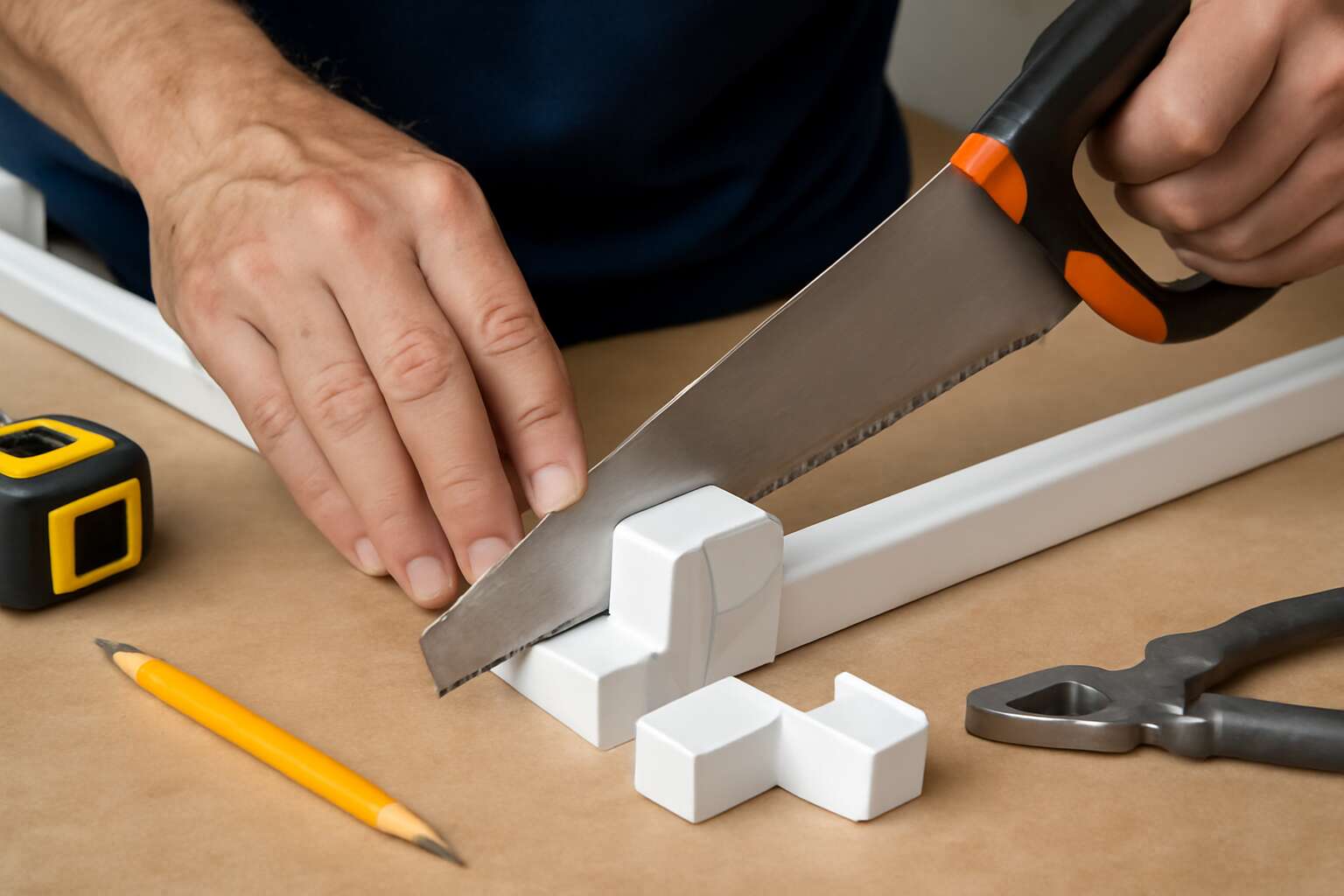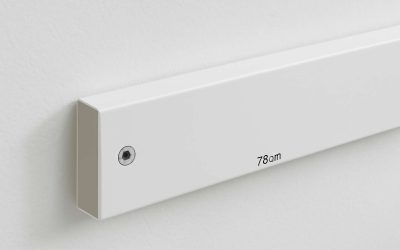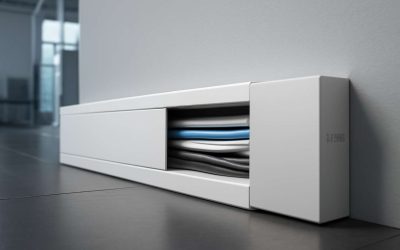Tools and Materials Needed for Cutting Trunking at 90 Degrees
Cutting Tools
When learning how to cut trunking 90 degree, having the right tools and materials at hand is essential for a clean, precise finish. A high-quality hacksaw or a power jigsaw fitted with a fine-toothed blade can make all the difference, especially when navigating tight corners. These tools provide the control needed to achieve a perfect 90-degree angle without damaging the trunking’s integrity.
For those aiming for accuracy, a miter box can be a valuable addition. It ensures consistent cuts and helps maintain the right angle throughout the process. Alongside the cutting tools, you’ll need a measuring tape and a marker to mark the cut line clearly. Proper safety gear, such as gloves and eye protection, is also crucial to prevent injury during the cutting process.
Here’s a quick overview of the essential tools and materials for how to cut trunking 90 degree:
- Hacksaw or power jigsaw with fine blades
- Miter box for precision cuts
- Measuring tape and marker
- Safety gloves and goggles
Equipped with these tools, you’ll be well on your way to mastering how to cut trunking 90 degree with confidence and professional results. Remember, patience and accuracy are key in this task!
Measurement and Marking Tools
In the shadowy realm of trunking installation, precision is the only salvation. To master the art of how to cut trunking 90 degree, one must first arm oneself with the tools of measurement and marking. These seemingly simple instruments serve as the silent guardians of accuracy, whispering the secrets of a perfect cut. A measuring tape, sturdy and unyielding, unravels the length needed, while a fine-tipped marker sketches the line that guides your blade through the darkness.
It’s essential to remember that a steady hand and unwavering focus are crucial. For those seeking unwavering precision, a miter box becomes an invaluable ally—its slots guiding your saw with relentless discipline. The goal is to carve a clean, true 90-degree angle, avoiding jagged edges that threaten to compromise your work. When wielding these tools, patience is your most potent weapon, ensuring that each cut is as precise as a dagger’s thrust in the midnight gloom.
Here’s a quick overview of the tools necessary for your journey into the shadows of trunking mastery:
- Measuring tape and marker for accurate measurement and marking
- A miter box for consistent, precise cuts
- Safety gloves and goggles to guard against unseen perils
With these implements at your disposal, you will unlock the secret of how to cut trunking 90 degree with the finesse of a seasoned craftsman, navigating the darkness with confidence and skill.
Safety Equipment
When it comes to cutting trunking at a perfect 90-degree angle, safety is just as important as precision. Equipping yourself with the right safety equipment ensures you’re protected from potential hazards during the process. Protective gloves guard against sharp edges, while safety goggles shield your eyes from flying debris—an often overlooked but vital aspect of safe trunking installation.
In addition to personal protective gear, having the appropriate materials on hand makes all the difference. Durable cutting mats or scrap wood can stabilize the trunking, preventing slips and ensuring a clean cut. A sturdy work surface provides stability, especially when working with larger sections of trunking, making the task safer and more manageable.
For added safety, some professionals recommend using a dust extraction system or a vacuum attachment to keep the workspace clear of debris. This not only maintains visibility but also reduces the risk of inhaling fine particles. When learning how to cut trunking 90 degree, investing in quality safety equipment and materials transforms a potentially hazardous task into a smooth, controlled process that delivers professional results every time.
Additional Supplies
Mastering how to cut trunking 90 degree with precision requires more than just the right tools—it demands the right materials to support a clean, professional finish. When working on intricate angles, stability becomes paramount. A solid work surface ensures the trunking remains steady, preventing slips that could ruin your perfectly measured cut. For added control, many professionals turn to durable cutting mats or scrap wood, which act as reliable guides during the process.
Beyond the essentials, having the right supplementary supplies can elevate your craftsmanship. For example, a fine-tooth saw or a specialized trunking cutter ensures smooth, accurate cuts without jagged edges. A combination square or angle guide helps maintain exact 90-degree angles, especially when tailoring trunking to fit snugly in tight corners or awkward spaces.
In the pursuit of flawless results, some experts recommend keeping a set of clamps handy. These keep your trunking firmly pressed against the work surface, reducing vibrations and helping you achieve that crisp, clean cut every time. When learning how to cut trunking 90 degree, these additional supplies aren’t just helpful—they’re essential for professional-grade outcomes!
Preparation Before Cutting Trunking
Measuring and Marking the Cut Line
In the intricate dance of electrical installation, precision is paramount—an unerring sense of timing and accuracy can spell the difference between seamless functionality and costly mishaps. When contemplating how to cut trunking 90 degree, one must first embrace a meticulous approach to preparation. The process begins with measuring and marking the cut line, a step that demands unwavering focus. Using a reliable measurement and marking tool, carefully delineate the exact point where the trunking will be divided, ensuring the line is crisp and unambiguous. This stage is crucial; a slight miscalculation can cascade into misaligned joints or compromised aesthetics.
To facilitate a clean cut, consider creating a detailed plan that includes the layout of the trunking run, factoring in bends and junctions. A well-structured plan minimizes guesswork and enhances overall efficiency. When marking the cut line, take into account the thickness of the trunking material, as this influences the type of cut required. The precision in measurement and marking is the foundation upon which all subsequent steps rest, dramatically affecting the ease and quality of how to cut trunking 90 degree with professional finesse!
Choosing the Right Trunking Type and Size
Choosing the right trunking type and size is a pivotal step in mastering how to cut trunking 90 degree with precision. In the vibrant landscape of South African electrical installations, selecting the appropriate materials ensures durability and seamless connectivity. Consider the environment where the trunking will be installed—will it face exposure to moisture, heat, or physical impact? This insight guides you in selecting from PVC, steel, or aluminum options, each offering unique advantages.
Furthermore, the size of the trunking must harmonize with the cable load and the spatial constraints of the installation site. A trunking that’s too narrow can lead to overcrowding, risking overheating and damage, while one that’s overly generous might compromise aesthetics. To streamline your decision, take into account the number of cables, their diameter, and the bend radius required for those perfect 90-degree cuts. Remember, a well-chosen trunking type and size lay the foundation for a flawless cut and a robust electrical setup.
Securing the Trunking for a Precise Cut
Preparation is the cornerstone of a clean and precise 90-degree cut when working with trunking. Before grabbing your cutting tool, ensure the trunking is securely supported to prevent any unwanted movement. A stable trunking surface guarantees accuracy and safety, especially when working with longer sections or heavier materials. The ideal setup involves clamping the trunking firmly to a workbench or using specialized supports that keep it steady during the cut.
To achieve a perfect 90-degree angle, it’s crucial to mark the cut line meticulously. Use a sharp marker or scribe to draw a clear, straight line along the measured point—precision here sets the tone for the entire project. For added stability, consider placing small blocks or wedges underneath the trunking to prevent any shifting. Remember, a well-secured trunking not only makes the cut easier but also minimizes the risk of damaging the material or compromising the electrical installation’s safety standards.
When it comes to securing the trunking for a precise cut, a combination of clamps and supports often proves most effective. For instance, an adjustable clamp can hold the trunking firmly in place, while a supporting jig aids in maintaining the exact 90-degree angle. If you’re working with longer or more unwieldy sections, it’s advisable to double-check the alignment before making your cut. This careful preparation ensures that your cut is both accurate and clean, laying a solid foundation for a professional electrical setup.
Step-by-Step Guide to Cutting Trunking at 90 Degrees
Marking the Cut Line
In the silent gloom of a workshop, where shadows dance upon the tools of transformation, knowing how to cut trunking 90 degree becomes an art as much as a skill. The precise marking of the cut line is the first step in this spectral ritual—every line drawn with deliberate intent, etched into the material like a secret prophecy. Use a sharp pencil or marker to trace the exact angle, ensuring your cut aligns with the intended corner. The darkness of the cut demands accuracy, for a crooked slice can unravel the entire fabric of your installation.
Once the line is marked, the process unfolds with a steady hand and unwavering focus. Whether employing a hacksaw, a power saw, or a specialized trunking cutter, the key lies in maintaining a consistent, even pressure. For those seeking a perfect 90-degree cut, a miter box or guide becomes an invaluable ally—think of it as a guardian of precision in an otherwise chaotic world. As the blade bites into the trunking, patience becomes your most trusted companion, revealing the clean, sharp edge that transforms raw material into a conduit of connectivity.
Using the Correct Cutting Technique
Step-by-Step Guide to Cutting Trunking at 90 Degrees Using the Correct Cutting Technique
Mastering the art of how to cut trunking 90 degree isn’t just about wielding the right tools; it’s about unlocking a secret precision that transforms rough materials into seamless conduits. When you approach this task with patience and meticulous attention, the results speak for themselves. The process begins with a confident, clean cut—one that will define the efficiency and safety of your electrical installation.
First, secure the trunking firmly—stability is key. Using a sturdy work surface or clamps prevents any unwanted movement that could compromise the cut’s accuracy. Next, align your marked line with a guide or miter box. This device acts as an unyielding guardian of accuracy, guiding your saw blade perfectly along the intended angle. Whether you’re wielding a hacksaw or a power saw, maintaining a steady, even pressure is paramount. Rushing the cut can cause splintering or uneven edges that would undermine the entire project.
For those seeking a flawless 90-degree angle, consider making multiple shallow passes rather than trying to cut through in one go. This technique preserves the integrity of the trunking and results in a cleaner finish. When the cut is complete, inspect the edge for any roughness and smooth it with a fine file if necessary. Achieving a perfect 90-degree cut on trunking isn’t merely a skill—it’s an act of craftsmanship that elevates your entire installation.
Handling the Trunking During the Cut
Handling trunking during the cut is where the real magic—or chaos—happens. You want to keep the trunking steady as a rock, because even the slightest wobble can turn your perfect 90-degree cut into a jagged mess. Imagine a surgeon wielding a scalpel—precision is everything! To keep things smooth, use clamps or a sturdy work surface. This ensures the trunking doesn’t shift mid-slice, which could compromise the entire project.
Once secured, align your marked line meticulously with your cutting guide or miter box. This is the secret to mastering how to cut trunking 90 degree—accuracy starts with good alignment. When you’re ready to saw, remember: steady, even pressure is key. Rushing or applying uneven force risks splintering or uneven edges. Instead, take your time, and consider making several shallow passes if you’re using a power saw. This technique preserves the integrity of the trunking and keeps edges clean and true.
After the cut, don’t forget to inspect the edge carefully. Any roughness or splinters? A quick pass with a fine file or sandpaper will smooth out imperfections and ensure a professional finish. The goal is a flawless 90-degree cut that fits perfectly into your electrical installation—because in the world of trunking, a neat cut isn’t just aesthetics, it’s about safety and efficiency too.
Finishing Touches After Cutting
Smoothing the Edges
Once you’ve taken the plunge and successfully cut your trunking 90 degree angle, the finishing touches become the cherry on top of your DIY cake. Smooth, clean edges not only improve the aesthetic but also prevent snagging or damage to cables—because nobody wants a frayed wire party. A quick pass with fine-grit sandpaper or a file can work wonders, erasing any jagged bits and leaving a polished edge that looks professional. Think of it as giving your trunking a mini spa treatment—because even plastic deserves a little TLC.
If you want to go the extra mile, consider applying a heat gun or a sanding block to gently round off rough edges. This simple step can make a world of difference in the longevity of your installation. Remember, precision in finishing touches after cutting ensures your 90 degree cut is not just accurate but also safe and visually appealing. After all, knowing how to cut trunking 90 degree is only half the story—it’s the finishing touches that truly elevate your handiwork!
Checking the Cut for Accuracy
As the final curtain falls on your meticulous craftsmanship, the importance of thorough quality checks becomes undeniably clear. When learning how to cut trunking 90 degree, the precision of your cut is the silent guardian of a seamless installation. A hurried glance can sometimes mask subtle imperfections that may compromise both safety and aesthetic appeal. By carefully examining your work, you ensure that every angle is sharp, every edge true, and every joint snug—like the perfect puzzle piece fitting into place.
To ensure your cut is flawless, hold the trunking up to the light and scrutinize the line for any deviations or jagged edges. A quick run along the edge with a fine file or sandpaper can reveal hidden imperfections, transforming roughness into a polished finish. Remember, in the realm of trunking, accuracy is the keystone that holds everything together—so take a moment to check your work before proceeding further.
Some seasoned installers even use a small square or angle gauge to verify that their 90 degree cut maintains perfect perpendicularity. It’s the small details that distinguish a professional finish from a novice’s effort. When you combine diligent checking with a keen eye for detail, your trunking installation will not only look sharp but also stand the test of time. Because, after all, mastering how to cut trunking 90 degree is only truly complete once you’ve confirmed that every cut is precise, every edge smooth, and every joint secure.
Preparing for Installation
Once your cut is precise and the edges are smooth, the finishing touches become paramount to a professional trunking installation. These small details elevate your work from average to exceptional, ensuring longevity and a clean aesthetic. Preparing for installation involves a meticulous check of each piece—making sure there are no rough edges or splinters that could snag wires or compromise the integrity of the fit. A quick wipe with a damp cloth removes dust and debris, revealing the true quality of your cut. This step is crucial because dust or debris can cause misalignments or hinder proper joint connections, especially when learning how to cut trunking 90 degree with accuracy.
To ensure seamless assembly, some seasoned installers advocate for a final inspection with a small square or angle gauge. This verifies that the cut maintains perfect perpendicularity, crucial for tight joints and a sleek finish. Additionally, applying a light coat of sealant or edge protector can prevent future damage, especially in humid environments or outdoor settings where trunking is exposed to the elements. The goal is to create a polished, professional look that will stand the test of time. When you master these finishing touches, your installation not only looks sharp but also functions flawlessly—proof that paying attention to detail makes all the difference in how to cut trunking 90 degree.
- Clear away any dust or debris for a pristine finish
- Use a small square or angle gauge to verify perpendicularity
- Apply edge protection or sealant for added durability
Tips and Precautions for Cutting Trunking Safely and Effectively
Safety Tips
When it comes to cutting trunking 90 degree angles, safety should never be an afterthought. A misstep can lead to jagged edges or, worse, injuries on site. Ensuring proper precautions are in place not only protects you but guarantees a professional finish. Always wear the appropriate safety equipment—gloves, goggles, and dust masks—to shield yourself from sharp edges and dust inhalation. Additionally, make sure the trunking is securely fastened to a stable surface before starting the cut. This minimizes the risk of slipping, which can cause uneven cuts and potential accidents. Remember, patience and precision are key—rushing through the process can compromise safety and accuracy. Use the right tools for the job, and double-check measurements before making any cuts, especially when cutting trunking 90 degree angles. The goal is a clean, precise cut that fits perfectly, with safety never being compromised in the process!
Troubleshooting Common Issues
Mastering how to cut trunking 90 degree angles is a skill that demands both patience and precision. Even the most experienced installers know that a small miscalculation can lead to jagged edges or compromised structural integrity. To avoid these pitfalls, it’s crucial to approach each cut with a calm hand and a clear mind, ensuring the cut line is accurate before wielding your tools. Troubleshooting common issues, such as uneven edges or misaligned angles, often boils down to double-checking measurements and maintaining steady pressure during the cut. If you encounter resistance, don’t force the blade—pause, reassess, and adjust your approach. Remember, the integrity of the entire installation hinges on how well you execute this step. When done correctly, the result is a seamless, professional finish that perfectly fits your trunking system, elevating the entire project with minimal fuss.
Maintenance and Care of Tools
Safety and efficiency are paramount when learning how to cut trunking 90 degree angles. Proper precautions can prevent accidents and ensure a clean, precise cut every time. Always wear safety equipment such as goggles and gloves to protect against flying debris and sharp edges. It’s also wise to inspect your tools before each use—dull blades or damaged equipment can compromise the quality of your cut and pose safety risks.
Maintaining your tools is a crucial aspect of effective trunking work. Regularly cleaning and lubricating cutting blades extends their lifespan and preserves their sharpness. After completing a cut, wipe down your tools to remove dust and residue, preventing buildup that could affect future cuts. Remember, well-maintained tools lead to more accurate cuts and safer working conditions, making your job smoother and more professional.




0 Comments